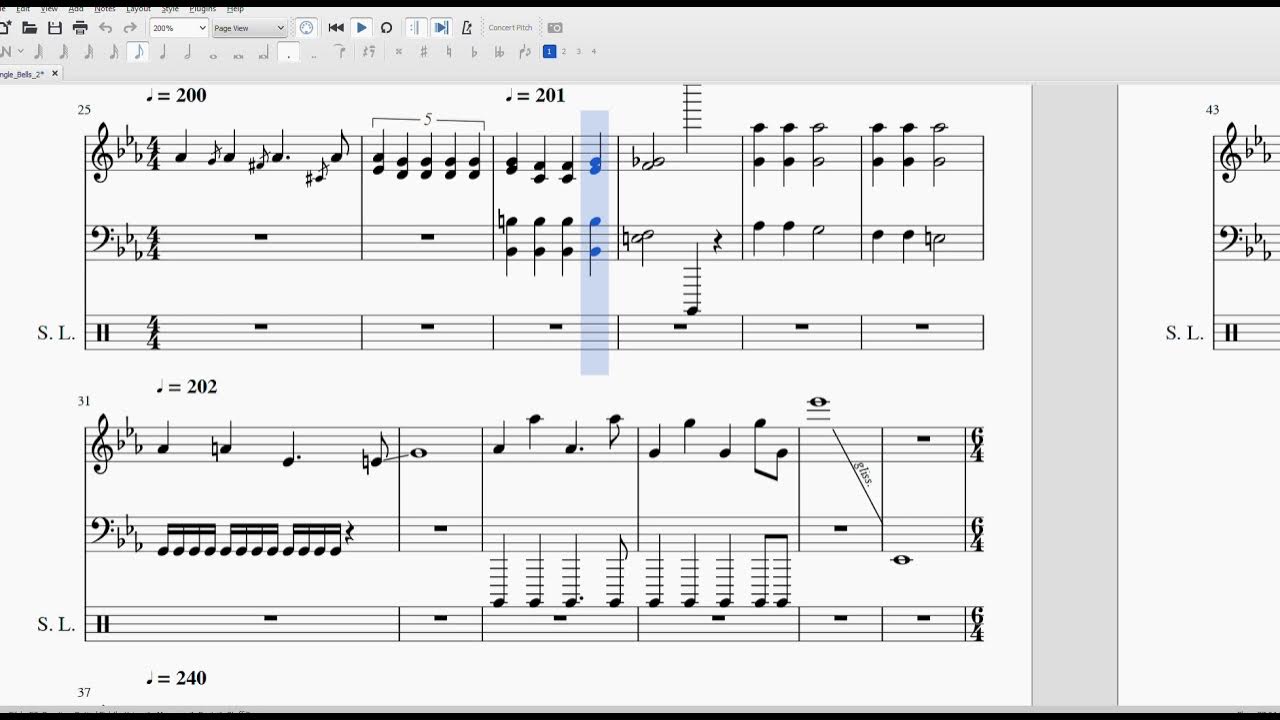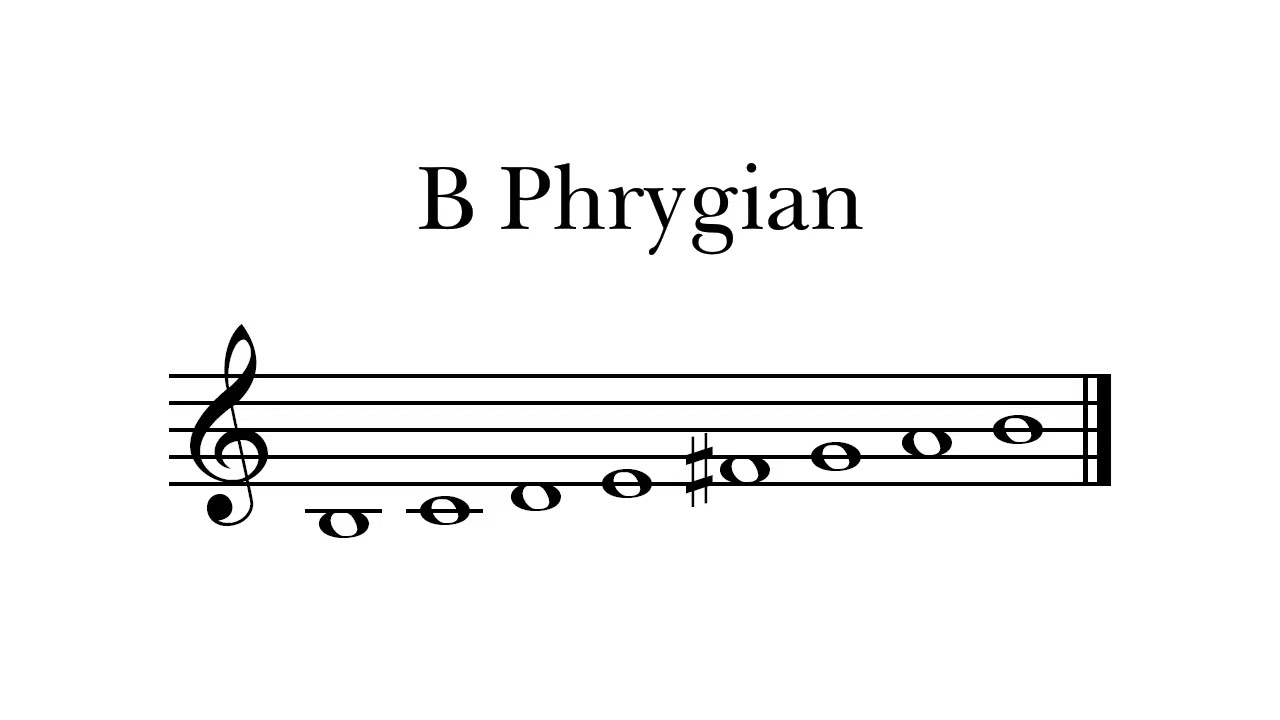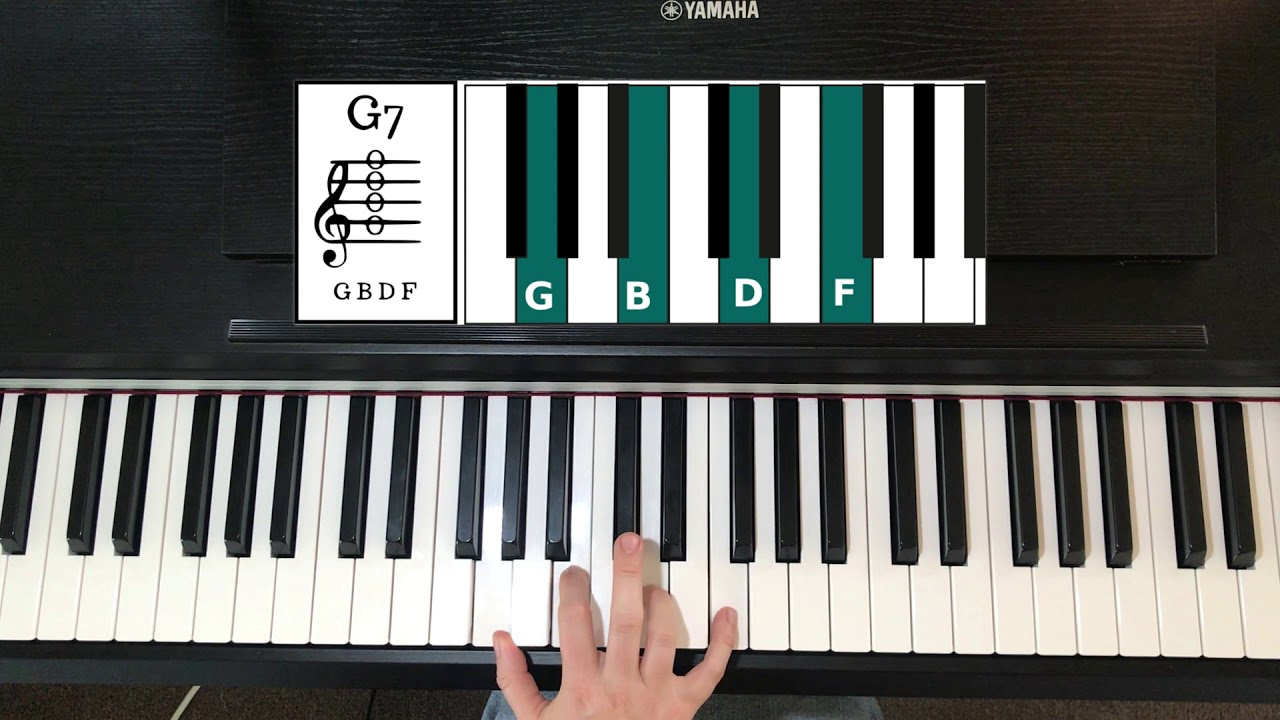Home>Production & Technology>Music Theory>Music Theory How To Write Out Chords


Music Theory
Music Theory How To Write Out Chords
Modified: February 1, 2024
Learn how to write out chords in music theory and improve your understanding of chord progressions. Explore the basics of constructing chords and create harmonies with confidence.
(Many of the links in this article redirect to a specific reviewed product. Your purchase of these products through affiliate links helps to generate commission for AudioLover.com, at no extra cost. Learn more)
Table of Contents
Introduction
Welcome to the world of music theory! If you’ve ever wondered how musicians create those beautiful harmonies and captivating chord progressions, you’re in the right place. Understanding music theory is essential for any aspiring musician, whether you’re a songwriter, composer, or performer. And one fundamental aspect of music theory is learning how to write out chords.
Chords form the building blocks of music, providing the harmonic foundation for melodies and creating depth and emotion in a song. They consist of multiple notes played simultaneously, and knowing how to construct and write out chords is vital for creating compelling compositions.
In this article, we will take you through a step-by-step guide on how to write out chords. We’ll break down the process into easy-to-follow steps, enabling you to build chords from scratch and gain a deeper understanding of their structure and function within a musical context.
By the end of this article, you will be equipped with the knowledge and skills to confidently create your own chords and progressions, allowing you to express yourself more fully as a musician. So, let’s dive in and unlock the mysteries of chord writing!
Understanding Basic Music Theory
Before we delve into the world of chord writing, let’s take a moment to understand some basic music theory concepts. Music theory is the underlying framework that governs how music is constructed and organized. It encompasses elements such as melody, harmony, rhythm, and form.
At its core, music theory helps us make sense of the relationships between different musical elements, allowing us to create and appreciate music on a deeper level. By understanding the basic principles of music theory, you’ll have a solid foundation for writing chords and composing your own music.
Some key concepts to grasp include:
- Notes and the Musical Alphabet: In music, we have a set of notes represented by letters from A to G. These notes repeat in a cycle, known as an octave.
- Scales: Scales are sequences of notes that form the basis of melodies and harmonies. The most common scale is the major scale, which consists of seven notes.
- Intervals: Intervals are the distances between two notes. They can be measured in half steps or whole steps and determine the character and mood of a chord or melody.
- Chords: Chords are constructed by stacking multiple notes together. They provide the harmonic foundation of a song and convey different emotions based on their structure.
- Chord Progressions: Chord progressions are sequences of chords that form the framework of a song. They create tension and release, shaping the overall emotional journey of the music.
By familiarizing yourself with these concepts, you’ll be better equipped to write out chords and understand how they fit into the broader musical landscape. So, let’s build on this foundation and explore the world of chord writing!
What are Chords?
Chords are groups of three or more notes played simultaneously, producing harmony and adding richness to music. They serve as the building blocks of harmony in a piece, providing a sense of stability and support for melodies. Chords are essential in creating the emotional and harmonic foundation of a song.
Each chord consists of a root note, along with additional notes that determine its quality and character. The root note is the foundation upon which the chord is built, and it gives the chord its name. For example, a C major chord has C as its root note.
Chords are often represented symbolically with chord symbols or chord names. These symbols are a shorthand way of communicating the chord’s structure and function. For example, a C major chord is commonly represented as “C” or “Cmaj” in shorthand notation.
Chords can be categorized into different types based on their structure and tonal qualities. Some common chord types include:
- Major Chords: Major chords have a happy or bright sound. They consist of a root note, a major third, and a perfect fifth interval.
- Minor Chords: Minor chords have a sad or melancholic sound. They include a root note, a minor third, and a perfect fifth interval.
- Dominant Chords: Dominant chords have a tense or resolving sound. They have a root note, a major third, a perfect fifth, and a minor seventh interval.
- Diminished Chords: Diminished chords have a dissonant or unresolved sound. They consist of a root note, a minor third, and a diminished fifth interval.
- Augmented Chords: Augmented chords have a tense or unresolved sound. They include a root note, a major third, and an augmented fifth interval.
Understanding the different types of chords is crucial for creating a wide range of musical moods and emotions. By combining different chords and varying their progression, you can evoke different feelings and captivate listeners with your music.
Now that we have a basic understanding of chords, let’s dive into the step-by-step process of writing out chords!
Writing Out Chords: Step-by-Step Guide
Now that we have a grasp of what chords are, let’s explore the step-by-step process of writing them out. This guide will walk you through each stage, from identifying the key to building the chord structure. So, let’s dive in and start creating some beautiful chords!
Step 1: Identify the Key
The first step in writing out chords is to identify the key of the song or musical piece you’re working with. The key is the central note or tonal center around which the other notes and chords revolve. It sets the overall tonality and determines the scale that will be used.
To identify the key, you can start by analyzing the melody or the underlying harmony of the piece. Look for recurring notes or chords that have a sense of resolution or stability. This note or chord is likely the key of the song.
Step 2: Determine the Scale
Once you have identified the key, the next step is to determine the scale that corresponds to that key. A scale is a series of notes that create a specific musical pattern. It provides the foundation for building chords and melodies.
The most common scale used in music is the major scale. However, depending on the genre and style of music you’re working with, there are other scales you can explore, such as the natural minor scale, harmonic minor scale, or various modes.
Step 3: Select the Root Note
After determining the scale, you will need to select the root note for your chord. The root note is the starting point and foundation of the chord. It is the note from which the chord gets its name.
The root note is typically the first note of the scale. For example, if you’re working with the key of C major, the root note would be C. Selecting the root note sets the tonal center for your chord and determines the overall key and quality of the chord.
Step 4: Build the Chord
With the root note selected, it’s time to build the chord. The basic structure of a chord includes the root note, a third, and a fifth. The third and fifth intervals create the harmonies and tonal qualities of the chord.
The type of chord you want to create will determine the specific intervals needed. For instance, a major chord requires a major third and perfect fifth, while a minor chord requires a minor third and perfect fifth.
To build the chord, count the intervals from the root note in the chosen scale. For example, in the key of C major, a C major chord would include the notes C, E, and G.
Step 5: Add Additional Notes (Optional)
Once you have built the basic chord structure, you can choose to add additional notes to enhance the texture and complexity of the chord. These additional notes are often referred to as extensions or embellishments.
Common additions include seventh chords, which include the seventh note of the scale, and suspended chords, which involve replacing the third with a second or fourth. Experimenting with these additional notes can add depth and color to your chord progressions.
By following these step-by-step instructions, you can confidently write out chords and create your own unique harmonic progressions. Remember to experiment and explore different chord types and variations to add nuance and complexity to your music.
Now that you understand the process of writing out chords, let’s explore some common chord progressions and how they can be used in your compositions.
Step 1: Identify the Key
The first step in writing out chords is to identify the key of the song or musical piece you’re working with. The key serves as the tonal center, around which the other notes, chords, and melodies revolve. It sets the overall tonality and establishes the foundation for chord progressions.
Identifying the key can be done by analyzing the melody or underlying harmony of the piece. Look for recurring notes or chords that have a sense of resolution or stability. These notes or chords often serve as a musical anchor and indicate the key.
One common technique to identify the key is by listening to the final note or chord of a phrase or section. If it sounds resolved and final, it is likely the tonic note of the key. For example, if a song consistently resolves to a C chord, there’s a good chance that the song is in the key of C major.
Another approach is to identify the primary chord progression in the song. In many cases, the progression starting with the tonic chord (the chord built on the key’s root note) will be a clue to the key. For instance, in the key of G major, a progression starting with a G chord and moving to other related chords like C and D, would indicate the key of G major.
You can also look for key signature indicators. Key signatures are symbols often found at the beginning of a musical piece or on each staff line, indicating the key and the sharps or flats present within that key. Pay attention to these symbols and use them as a clue to determine the key.
Remember that identifying the key is not an exact science and may require some ear training and musical analysis. It’s common for songs to modulate or change keys throughout, so be attentive to any key changes that may occur.
By accurately identifying the key, you establish a solid foundation for writing out chords and creating harmonic progressions that complement the melody. Once you have identified the key, you can move on to the next step of determining the scale, which we will explore in the following section.
Step 2: Determine the Scale
Once you have identified the key of the song or musical piece, the next step in writing out chords is to determine the scale that corresponds to that key. A scale is a group of notes arranged in a specific pattern, and it serves as the foundation for building chords and melodies.
The most common scale used in music is the major scale, which follows a specific pattern of whole steps and half steps. However, different genres and musical styles may utilize different scales, such as the natural minor scale, harmonic minor scale, or various modes.
To determine the scale, you need to understand the pattern of intervals within the chosen key. For example, the pattern for the major scale is whole step, whole step, half step, whole step, whole step, whole step, and half step. Starting from the root note of the key, you apply this pattern to determine the notes in the scale.
Let’s take the key of C major as an example. The pattern of the major scale in the key of C is C-D-E-F-G-A-B-C. By following the whole step and half step pattern, you can derive the notes that belong to the C major scale.
It’s important to note that when determining the scale, the notes within that scale become the foundation for building chords. Each note in the scale has a specific relationship with the root note, serving as a potential chord tone.
Understanding the scale associated with the key allows you to choose the appropriate notes for building chords that will harmonize well with the melody. It gives you a roadmap for crafting chord progressions that evoke the desired emotional qualities and musical styles.
Remember that while the major scale is the most common, exploring different scales can add variety and depth to your chord progressions. Experimentation with different scales can help you create unique sounds and explore new musical territories.
With the key identified and the scale determined, you are ready to proceed to the next step of selecting the root note, which we will explore in the following section.
Step 3: Select the Root Note
After determining the scale associated with the key of the song or musical piece, the next step in writing out chords is to select the root note. The root note serves as the foundation and starting point for building the chord.
The root note is crucial as it defines the name and tonal center of the chord. It is the note from which the chord takes its identity and around which the other chord tones will revolve. The root note is typically the first note of the scale.
To select the root note, refer back to the determined scale of the key. For instance, if the key is C major and the scale consists of the notes C, D, E, F, G, A, and B, you would choose C as the root note because C is the starting point of the scale.
It’s important to note that the choice of the root note will determine the overall key and tonality of the chord. For example, a C root note will result in a C major chord, while a D root note will create a D minor chord if following the natural minor scale.
When selecting the root note, it’s helpful to keep the melody and overall song structure in mind. The root note should align with the desired tonal center and complement the melody. Consider how the root note interacts with the other notes in the scale when building chords.
Remember that the root note provides the “home base” for your chords and establishes a sense of stability and resolution. It serves as a reference point for the listener and helps create a cohesive musical structure.
By selecting the root note, you establish the tonal center and lay the groundwork for building chords that support the melody and overall composition. With the root note chosen, you can now move on to the next step of building the chord structure, which we will explore in the following section.
Step 4: Build the Chord
Once you have selected the root note, the next step in writing out chords is to build the chord itself. The chord structure consists of the root note, along with additional notes that determine its quality and character.
The basic structure of a chord includes the root note, a third, and a fifth. The third and fifth intervals create the harmonies and tonal qualities of the chord. The type of chord you want to create will determine the specific intervals needed.
Let’s take the example of a C major chord. With the root note selected as C, we can build the chord by adding the third and fifth notes from the C major scale. In the C major scale (C-D-E-F-G-A-B), the third note is E and the fifth note is G. Therefore, a C major chord consists of the notes C, E, and G.
Similarly, if you were building a D minor chord, the root note would be D, and you would add the third (F) and the fifth (A) notes from the D natural minor scale (D-E-F-G-A-B♭-C). Thus, a D minor chord consists of the notes D, F, and A.
It’s important to understand that the quality of the chord is determined by the intervals between the root note, third, and fifth. For example, a major chord has a major third interval (four half steps) and a perfect fifth (seven half steps), while a minor chord has a minor third (three half steps) and a perfect fifth.
Experimenting with different chord structures allows you to create a variety of moods and emotions in your music. By altering the intervals or adding different chord tones, you can explore different chord qualities like augmented, diminished, or dominant chords.
Remember to consider the melody and overall musical context when building chords. Each note within the chord should complement the melody and harmonize well with the other chords in the song. Pay attention to the intervals between the chord tones to create pleasing harmonic progressions.
By building the chord structure, you establish the characteristic sound and tonality of the chord. With the chord structure in place, you can move on to the optional step of adding additional notes to enhance the texture and complexity of the chord, which we will explore in the next section.
Step 5: Add Additional Notes (Optional)
Once you have built the basic chord structure, you have the option to add additional notes to the chord. These additional notes, known as extensions or embellishments, can add depth, color, and complexity to your chord progressions.
Commonly added notes include seventh chords and suspended chords. A seventh chord involves adding the seventh note of the scale to the basic chord structure. For example, adding the seventh note (B) to a C major chord creates a Cmaj7 chord.
Suspended chords, on the other hand, involve replacing the third note of the chord with a second (sus2) or fourth (sus4) note from the scale. This creates a harmonic tension, giving the chord a unique sound. For instance, in a C major chord, replacing the third note (E) with a D results in a Csus2 chord, while replacing it with an F creates a Csus4 chord.
When deciding which additional notes to add, consider the desired mood and musical context. Experimenting with different extensions can help you create chord progressions that suit the style and emotions of your composition.
It’s worth noting that while adding additional notes can enhance the complexity of your chords, it’s important to avoid overcrowding or overwhelming the sound. As with any musical element, balance is key. Listen carefully to how the added notes interact with the melody and other instruments to ensure a cohesive and harmonically pleasing result.
Ultimately, the decision to add additional notes to your chords is a creative choice that depends on the musical style you’re working with and your personal preference. You may choose to keep your chords simple or experiment with a wide range of extensions to create intricate and sophisticated progressions.
With the chord structure and optional additional notes established, you have completed the process of writing out chords. The chords you have created can now be used to form chord progressions that shape the harmonic landscape of your music.
In the next section, we will explore some common chord progressions and how they can be used to create musical depth and emotional impact in your compositions.
Common Chord Progressions
Chord progressions are sequences of chords that form the backbone of a musical composition. They dictate the flow and direction of the music, creating tension and resolution, and adding emotional impact. Understanding common chord progressions can greatly enhance your ability to write engaging and captivating music.
Here are a few widely used chord progressions:
- I-IV-V: Known as the “three-chord trick,” this progression is highly popular and found in numerous songs across various genres. It involves using the I (tonic), IV (subdominant), and V (dominant) chords from a particular key. For example, in the key of C major, the I-IV-V progression would consist of the chords C, F, and G.
- I-V-vi-IV: This progression has been the basis for countless pop hits. It features the I, V, vi, and IV chords from a key. For instance, in the key of C major, the chords would be C, G, Am, and F. This progression creates a sense of familiarity and harmonic tension, followed by a satisfying resolution.
- ii-V-I: Commonly found in jazz music, this progression adds complexity and sophistication. It involves using the ii (supertonic), V (dominant), and I (tonic) chords from a key. In the key of C major, the chords would be Dm, G, and C. This progression creates a sense of forward motion and resolution.
- vi-IV-I-V: Often used in ballads and sentimental songs, this progression offers a smooth and emotional sound. It utilizes the vi, IV, I, and V chords from a key. For example, in the key of C major, the chords would be Am, F, C, and G. This progression evokes a sense of nostalgia and introspection.
- Circle of Fifths: The circle of fifths progression is a sequence of chords that move in fifths. It offers a satisfying and predictable resolution. The pattern starts with the I chord and moves sequentially through its dominant chord. For example, in the key of C major, the progression would be C, G, D, A, E, B, F#/Gb, Db, Ab, Eb, Bb, F, and back to C.
These are just a few examples of common chord progressions, but there are countless others you can explore and experiment with. Understanding these progressions provides a solid foundation for creating melodies, harmonies, and song structures that resonate with listeners.
While these progressions are tried and tested, don’t be afraid to break the mold and experiment with your own unique progressions. The beauty of music lies in its endless possibilities and creative expression.
Remember, the choice of chord progression should serve the mood, style, and intention of your music. Experiment with different progressions, chord inversions, and rhythmic variations to craft your own signature sound and captivate your audience.
Now that you have a good grasp of chord progressions, let’s conclude our exploration of writing out chords.
Conclusion
Congratulations! You’ve reached the end of our journey through writing out chords. Understanding how to construct chords and create harmonically rich progressions is a vital skill for any musician or songwriter.
We started by gaining a basic understanding of music theory and the role that chords play in creating harmony and depth in music. We explored the different types of chords, their structures, and how they contribute to the emotional landscape of a composition.
We then took you through a step-by-step guide to writing out chords, beginning with identifying the key and determining the scale associated with that key. We learned how to select the root note and build the chord structure, and even explored the option of adding additional notes to enhance the complexity and texture of the chords.
Finally, we delved into common chord progressions, giving you a taste of the patterns that have stood the test of time and continue to captivate listeners across various genres. These progressions serve as a starting point for your own musical exploration and experimentation.
Remember, music theory is a framework that provides guidance, but it’s also a playground for creativity. Feel free to bend and break the rules to discover your unique voice as a musician.
Now armed with the knowledge of chord writing, go forth and create! Use your understanding of chords to craft captivating melodies, intricate harmonies, and powerful compositions. Let your creativity soar as you explore new chord progressions and experiment with different moods and emotions.
Writing out chords is just the beginning of your musical journey. Continuously expand your knowledge and skills by practicing, listening to a wide range of music, and collaborating with other musicians.
So, embrace the power of chords, let them guide and inspire you, and enjoy the beautiful journey of musical creation. Happy composing!











